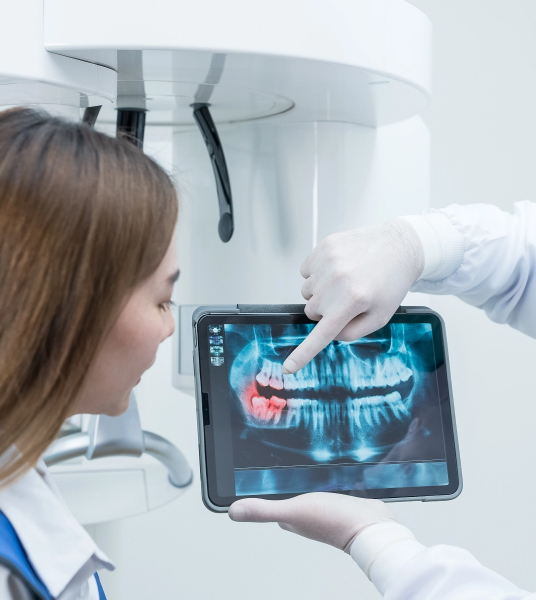PARO CHIRURGIE MONTRÉAL
Consulting a
dental specialist;
it’s the first step towards a healthy smile
Surgical procedures
Numerous surgical therapies are available to treat diseases of your gums, bone, and jaws. The objectives of these treatments may be to eliminate infection, stop the progression of the disease, or even correct esthetic abnormalities. Surgical procedures may include teeth extractions, bone grafts, pocket reduction surgeries, implant placements, etc.
Surgical treatment of periodontitis
Periodontal plastic surgery for correcting the gummy smile
Dental extraction with or without socket preservation
Dental implant placement (surgical phase)
All-on-4 and Zygomatic Implants
Surgical exposure of impacted teeth
Oral pathology and biopsy of soft or hard tissue
Impacted wisdom teeth extraction

Surgical treatment of periodontitis (pocket reduction surgery)
A surgical pocket reduction surgery involves reshaping of the bony defects around teeth, under local anesthesia. Gingival recontouring is often needed to ensure proper gingival adaptation. By eliminating a deep pocket around a tooth, the harmful bacteria no longer have an adequate environment for survival, and periodontal bone loss can no longer progress.
Sometimes, a regenerative approach may be used to reduce pockets during surgery. In that case, a bone graft and a collagen membrane can be placed under the gum, around the tooth, to create a favorable environment for bone regeneration and healing, again, leading to pocket elimination and periodontal heath.
Soft tissue grafting
Soft tissue grafting can be performed to correct a gingival recession or even to thicken gingiva in an edentulous site, or around a tooth or dental implant.
During a soft tissue grafting procedure, local anesthesia is performed, and a small layer of gingiva is removed from the roof of your mouth, and placed on the gum where it is needed, with sutures. It is sometimes possible to not use your palatal tissue for the graft, but rather use a tissue that comes from another human donor, a cadaver. The objectives of a soft tissue grafting procedure are to decrease tooth sensitivity, cover an exposed root, facilitate oral hygiene, increase comfort and improve esthetics.
Periodontal plastic surgery for correcting the gummy smile
It may be possible to correct a gummy smile with minimally invasive periodontal plastic surgeries, such as an esthetic crown lengthening surgery, (gingivectomy or gum recontouring surgery) or even a surgical repositioning of the upper lip.
Under local anesthesia, gingival and bony tissue is removed from around the tooth to give it a longer or fuller appearance. This will reduce the amount of gingiva exposed when smiling. Also, by making a small incision inside your mouth, it is possible to surgically correct the position of the upper lip, making it rise less high when smiling, therefore exposing less gum above your teeth, and correcting your gummy smile.
Dental extraction with or without socket preservation (bone graft)
A dental extraction may be recommended if a tooth has a large decay and can no longer be saved, or if the tooth has lost all it’s bone supporting it in your jaw. It is possible that your tooth may need to be extracted because it is malpositioned, not needed in your mouth, or impacted inside your gum or bone. This may be the case of wisdom teeth (3rd molars).
Sometimes, it may be recommended that a bone graft be placed inside your socket once the tooth is removed, in order to maintain the bony shape after extraction. This will not only help with maintain good esthetics, but will increase bone healing after extraction and prepare the area for a future dental implant placement.
Dental implant placement
(surgical phase)
A dental implant surgery placement is performed under local anesthesia. A titanium screw is placed inside the bone of your jaw. A small metal cap is placed on top usually, and a 3-4 month period is often needed to let the implant heal. Once it is healed and integrated inside your jawbone, your restorative dentist will e able to place a tooth (crown) on your implant in order to replace your missing tooth.

All-on-4 and Zygomatic Implants
All-on 4 is an alternative technique for patients who wear dentures or having a failing dentition and are soon to require a denture. Rather than having a removeable denture that has poor stability and limited bite force this technique uses typically 4 implants to support a full arch fixed prosthesis. The prosthesis or false teeth is screwed into the implants and is the most realistic alternative to natural teeth with over a 95% success rate at 10 years. With the All-on-4 technique the patient is able to have their teeth removed, the implants placed, and a temporary prosthesis placed the same day. A final prosthesis is typically fabricated 4-6 months later.
For patients with advance resorption of their maxilla (upper jaw), traditional dental implants cannot always be placed as there is insufficient bone to stabilize them. In these instances, longer implants called zygomatic implants are used to engage the thick zygoma bone (cheek bone). This is an advanced procedure that is typically carried out by an oral and maxillofacial surgeon.
Peri-implantitis treatment
Like periodontitis, peri-implantitis is a bacterial infection affecting the gums and bone around your dental implant. It is possible for plaque and calculus to contaminate the implant surface under the gum. This may lead to painful bleeding gums around implants, and bone loss surrounding the implant screw. This serious condition can lead eventually lead to implant loss if not treated in time.
Under local anesthesia, several surgical and non-surgical procedures exist to eliminate bacteria around the implant and stop the progression of peri-implant disease.

Surgical exposure of impacted teeth
It is possible for a tooth to stay partially stuck inside your gum or bone, and not fully erupt naturally inside your mouth. It may be the case for any teeth in your mouth, for supernumerary teeth, or often even wisdom teeth.
Under local anesthesia, it is possible to properly expose these impacted teeth in order to facilitate their eruption into place.
Labial or lingual frenectomy
A frenum is a small muscular tissue attachment that connects the tongue, lip or cheek to the neighboring structures inside your mouth. For various reasons, these attachments may be large and need to be sectioned or repositioned in a more adequate location. Under local anesthesia, these small muscle fibers are sectioned and sutures are placed to secure the tissue in the appropriate position.
Oral pathology and biopsy of soft or hard tissue
It is possible for a soft or hard tissue lesion to be noted in your mouth, jaw, or maxillofacial area. A proper examination is essential to establish if a removal of the lesion is needed. If a partial or complete removal is required, local anesthesia is administered and the lesion is removed. The specimen is sent for histo-pathological analyses to establish the correct diagnosis. Many oral or cutaneous conditions can affect the mouth or the maxilla-facial area. It is important to obtain an adequate diagnosis and follow up on these lesions if necessary.
Impacted wisdom teeth extraction
Wisdom teeth, also known as third molars, are the last teeth in the arch and because there is commonly a lack of space in the jaw for their eruption, they are often either partially or fully impacted in the jaw bone. As a result, they often will develop problems such a gum disease, caries, bone loss or resorption on the adjacent second molar, dental crowding, and/or cysts or tumors around them. Long term studies demonstrate that over 80% of patients will eventually need to have their wisdom teeth removed in their lifetime. As a result, we recommend a consultation with an oral and maxillofacial surgeon between the ages of 15-25, prior to the development of disease or pain to assess if the wisdom teeth require removal. Removal at this age is much simpler resulting in a quicker recovery and lower risk of issues during the healing process.
Tumor or cyst ablation and treatment of infection
Tumors, cysts or other types of infection may be present in your mouth or jaw causing you swelling, discomfort, or unpleasing esthetics. These lesions may need surgical removal. It may be appropriate to use a 3D scan to better evaluate these lesions and to determine what type of surgical treatment is needed.
Jaw surgery (orthognathic surgery)
Jaw surgery, also known as orthognathic surgery, aims to correct irregularities in the jawbones and the alignment of the teeth to improve the function of these structures. By making these corrections, the aesthetic appearance of the face may be improved as well.

Jaw surgery may be a corrective option if you have jaw problems that can't be resolved with orthodontics (braces) alone. In most cases, you also have braces on your teeth before surgery, and after surgery until healing and alignment are complete. Your orthodontist can work with your oral and maxillofacial surgeon to determine your treatment plan.
Jaw surgery is appropriate any time after growth stops, which is usually around ages 14 to 16 years for females and ages 16 to 18 years for males.
Jaw surgery may help to:
- Make biting and chewing easier and improve chewing overall
- Correct problems with swallowing or speech
- Minimize excessive wear and breakdown of the teeth
- Correct bite fit or jaw closure issues, such as when the molars touch but the front teeth don't touch (open bite)
- Correct facial imbalance (asymmetry); such as small chins, underbites, overbites and crossbites
- Improve the ability of the lips to fully close comfortably
- Relieve pain caused by temporomandibular joint (TMJ) disorder and other jaw problems
- Repair facial injury or birth defects
- Provide relief for obstructive sleep apnea